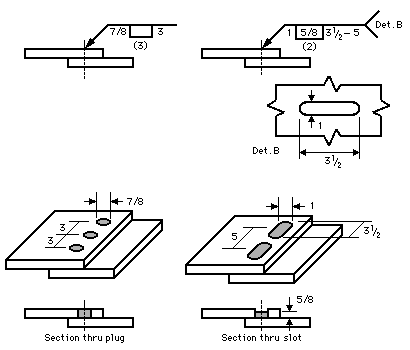By: Jim Oaks
Want to take a quick quiz to see if you can read some welding symbols before reading this article? If so, click HERE.
I have found over the years that there are many people out there who can weld. Some went to school. Some learned on their own in a garage somewhere. Some of those who say they can weld, don’t weld very well at all.
One of the things I found when looking to hire someone to do some welding for me is that there are many people who are welders but can’t read welding symbols.
Because of this, I thought I would put together some information to help those of you unfamiliar with welding symbols if you’re trying to follow a drawing.
Elements Of A Welding Symbol:
- A welding symbol may include the following elements:
- Reference Line
- Arrow
- Basic Weld Symbol
- Dimensions & Other Data
- Supplementary Symbols
- Finish Symbols
- Tail
- Specifications, Process, Or Other References
Reference Line:
A reference line is a horizontal line with all the other required information drawn on or around it. It must be placed on the drawing near the joint it describes.
Arrow:
The arrow is the other required part of a welding symbol and is placed at one or the other end of the reference line and connects the reference line to the joint that is to be welded.
Quite often, there are two sides to the joint to which the arrow points, and therefore two potential places for a weld. For example, when two steel plates are joined together into a T shape, welding may be done on either side of the stem of the T.

The weld symbol distinguishes between the two sides of a joint by using the arrow and the spaces above and below the reference line. The side of the joint to which the arrow points is known as the arrow side, and its weld is made according to the instructions given below the reference line. The other side of the joint is known as the other side, and its weld is made according to the instructions given above the reference line. The below and above rules apply regardless of the arrow’s direction.
Basic Symbols:
Each type of weld has its own basic symbol, which is typically placed near the center of the reference line (and above or below it, depending on which side of the joint it’s on). The symbol is a small drawing that can usually be interpreted as a simplified cross-section of the weld. In the descriptions below, the symbol is shown in both its arrow-side and other-side positions.

Weld All Around & Field Weld:
There are two other elements that may be seen on the reference line that provide information about the weld. One is a circle around the place where the leader line connects to the reference line and indicates the weld is “all around”. This means the weld extends all the way around the joint the arrow is pointing at.
The all around element is only used when it is possible to weld all the way around a single surface (see below).
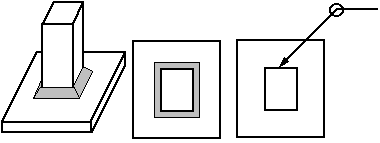
The other element seen on the reference line resembles a flag and is located where the leader line joins the reference line. This element is called a “field weld” and means the weld will be done in another location. For instance, this weld may be applied at the job site not in the shop. Sometimes clarification will be given in the welding symbol tail or as a specification on the print.
Field Weld Symbol
Fillet Weld:
The fillet weld (pronounced “fill-it”) is used to make lap joints, corner joints, and T joints. As its symbol suggests, the fillet weld is roughly triangular in cross-section, although its shape is not always a right triangle or an isosceles triangle. Weld metal is deposited in a corner formed by the fit-up of the two members and penetrates and fuses with the base metal to form the joint. (Note: for the sake of graphical clarity, the drawings below do not show the penetration of the weld metal. Recognize, however, that the degree of penetration is important in determining the quality of the weld.)
The perpendicular (straight up and down) leg of the triangle is always drawn on the left side of the symbol, regardless of the orientation of the weld itself. The leg size is written to the left of the weld symbol. If the two legs of the weld are to be the same size, only one dimension is given; if the weld is to have unequal legs (much less common than the equal-legged weld), both dimensions are given and there is an indication on the drawing as to which leg is longer.
The welding symbol above shows that the weld is to be done on the other side and the thickness of the weld is 5/16.
The length of the weld is given to the right of the symbol.
If no length is given, then the weld is to be placed between specified dimension lines (if given) or between those points where an abrupt change in the weld direction would occur (like at the end of the plates in the example above).
The Length & Pitch of Intermittent Welds:
An intermittent weld is one that is not continuous across the joint, but rather is a given length of weld separated by a given space between them. This method of welding may be used to control heat distortion or where the joint strength requirements allow. Intermittent welding can save time and money if a long weld is not necessary.
Used more frequently than the length alone, the length and pitch (length first, spacing second) are two numbers located at the right of the fillet weld symbol.
The length appears first as before followed by a hyphen then the pitch is shown.
The pitch refers to a dimension from the center of one weld to the center of the next weld.
The pitch is not the space between welds but a measurement from center to center of the welds. To get the spacing for layout subtract the length of one weld from the pitch.
The intermittent welds may be chain intermittent or staggered intermittent. Chain intermittent the welds on both sides of the joint are opposite each other and resemble a chain. Staggered intermittent the welds on the opposite side are usually started in the gap between the welds on the first side. The welds then appear staggered.
If the welds are staggered the fillet weld symbol will be staggered on the reference line.
Contours:
Some welding symbols may show a contour finish that details how the fillet weld shape must be finished after welding. The contour may be flat or convex (having a surface that is curved or rounded outward) and the element to describe this is placed above the slope on the fillet weld symbol. A letter to indicate the method of finish may be given above the finish element.
Groove Welds:

The groove weld is commonly used to make edge-to-edge joints, although it is also often used in corner joints, T joints, and joints between curved and flat pieces. As suggested by the variety of groove weld symbols, there are many ways to make a groove weld, the differences depending primarily on the geometry of the parts to be joined and the preparation of their edges. Weld metal is deposited within the groove and penetrates and fuses with the base metal to form the joint. (Note: for the sake of graphical clarity, the drawings below generally do not show the penetration of the weld metal. Recognize, however, that the degree of penetration is important in determining the quality of the weld.
Groove Weld Size – The groove weld size is given in two dimensions and like the fillet weld it is placed to the left of the weld symbol. The first size given is the depth of the groove and is the dimension used to prepare the edge preparation. The depth of groove is measured from the surface of the joint to the bottom of the preparation.
The depth of groove does not include weld reinforcement or root penetration.
The second size given is the actual weld size and is enclosed in parentheses to distinguish it from the groove size, or depth of groove.
The actual weld size is again measured from the surface of the groove through the bottom of the groove but now includes the expected penetration of the weld. On a square groove only the weld size is given.
The weld size does not include face reinforcement or root reinforcement.
Groove Opening & Angle – Two other important elements for preparing and welding the groove are the root opening and the groove angle. The root opening, when used, dimensions the space between the joint to be welded and is placed inside the weld symbol. The groove angle is also placed inside the weld symbol and is given in degrees.
The groove angle for a V groove is given as the included angle so that means the edge bevel or chamfer for each piece is 1/2 of the degrees given.
For example; A 45 degree included angle means bevel each member at 22 1/2 degrees. J grooves angles may be detailed elsewhere on the drawing. The root opening and groove angle are separate elements and may or may not appear together depending on the joint requirements.
On some drawings the root opening or groove angle will be covered in a note or specification on the drawing for all similar symbols, and does not appear on the symbol.
The Welder must always read all information given on a drawing.
Contour & Finishing – The same contour symbols that apply to fillet welds may be used with groove welding and are placed above the weld symbol.
Square Groove – The square groove weld, in which the “groove” is created by either a tight fit or a slight separation of the edges. The amount of separation, if any, is given on the weld symbol.

V-Groove – The V-groove weld, in which the edges of both pieces are chamfered, either singly or doubly, to create the groove. The angle of the V is given on the weld symbol, as is the separation at the root (if any).
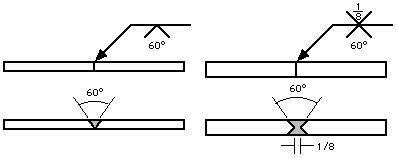
If the depth of the V is not the full thickness–or half the thickness in the case of a double V–the depth is given to the left of the weld symbol.

If the penetration of the weld is to be greater than the depth of the groove, the depth of the effective throat is given in parentheses after the depth of the V.
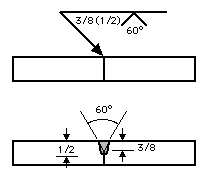
Bevel Groove – The bevel groove weld, in which the edge of one of the pieces is chamfered and the other is left square. The bevel symbol’s perpendicular line is always drawn on the left side, regardless of the orientation of the weld itself. The arrow points toward the piece that is to be chamfered. This extra significance is emphasized by a break in the arrow line. (The break is not necessary if the designer has no preference as to which piece gets the edge treatment or if the piece to receive the treatment should be obvious to a qualified welder.) Angle and depth of edge treatment, effective throat, and separation at the root are described using the methods discussed in the V-groove section above.
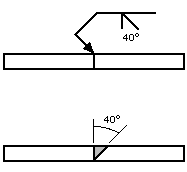
U-Groove – The U-groove weld, in which the edges of both pieces are given a concave treatment. Depth of edge treatment, effective throat, and separation at the root are described using the methods discussed in the V-groove section.
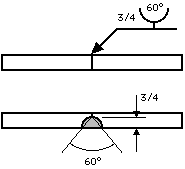
J-Groove – The J-groove weld, in which the edge of one of the pieces is given a concave treatment and the other is left square. It is to the U-groove weld what the bevel groove weld is to the V-groove weld. As with the bevel, the perpendicular line is always drawn on the left side and the arrow (with a break, if necessary) points to the piece that receives the edge treatment. Depth of edge treatment, effective throat, and separation at the root are described using the methods discussed in the V-groove section.

Flare V Groove – The flare-V groove weld, commonly used to join two round or curved parts. The intended depth of the weld itself are given to the left of the symbol, with the weld depth shown in parentheses.
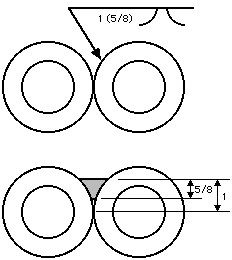
Flare Bevel Groove – The flare bevel groove weld, commonly used to join a round or curved piece to a flat piece. As with the flare-V, the depth of the groove formed by the two curved surfaces and the intended depth of the weld itself are given to the left of the symbol, with the weld depth shown in parentheses. The symbol’s perpendicular line is always drawn on the left side, regardless of the orientation of the weld itself.

Common supplementary symbols used with groove welds are the melt-thru and backing bar symbols. Both symbols indicate that complete joint penetration is to be made with a single-sided groove weld. In the case of melt-thru, the root is to be reinforced with weld metal on the back side of the joint. The height of the reinforcement, if critical, is indicated to the left of the melt-thru symbol, which is placed across the reference line from the basic weld symbol.
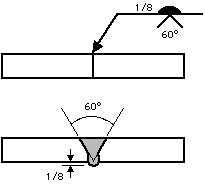
When a backing bar is used to achieve complete joint penetration, its symbol is placed across the reference line from the basic weld symbol. If the bar is to be removed after the weld is complete, an “R” is placed within the backing bar symbol. The backing bar symbol has the same shape as the plug or slot weld symbol, but context should always make the symbol’s intention clear.
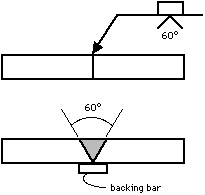
Plug & Slot Welds:

Plug welds and slot welds are used join overlapping members, one of which has holes (round for plug welds, elongated for slot welds) in it. Weld metal is deposited in the holes and penetrates and fuses with the base metal of the two members to form the joint. (Note: for the sake of graphical clarity, the drawings below do not show the penetration of the weld metal. Recognize, however, that the degree of penetration is important in determining the quality of the weld.)
For plug welds, the diameter of each plug is given to the left of the symbol and the plug-to-plug spacing (pitch) is given to the right. For slot welds, the width of each slot is given to the left of the symbol, the length and pitch (separated by a dash) are given to the right of the symbol, and a detail drawing is referenced in the tail. The number of plugs or slots is given in parentheses above or below the weld symbol. The arrow-side and other-side designations indicate which piece contains the hole(s). If the hole is not to be completely filled with weld metal, the depth to which it is to be filled is given within the weld symbol.
